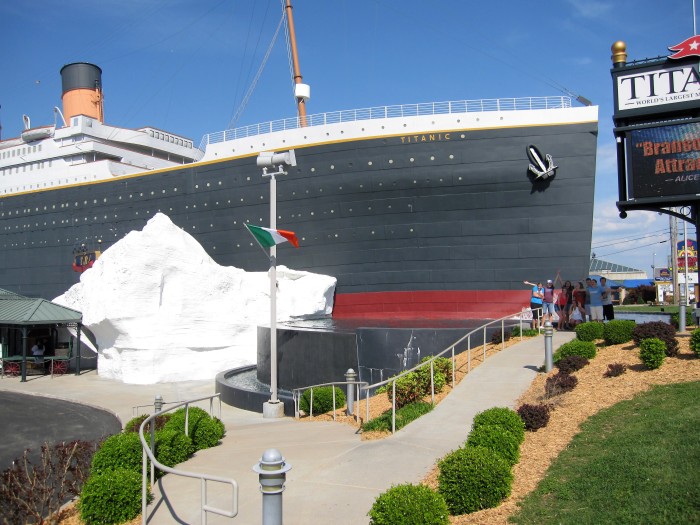
They say there’s a first time for everything.
What they don’t say is that sometimes there’s a second time, and this second time may come quickly after the first.
At least, that’s what happened last month when I ripped my pants.
Prior to then, I had never, ever, ever ripped a pair of pants. Sure, as a kid, I’d torn holes in the knees (a natural hazard of refusing to play “house” unless I could be the dog). One time I accidentally ripped a dress when I was running up the stairs. And of course I’ve retired some jeans after noticing signs of wear around the back pockets. But ripping them completely? That’s just the stuff of sitcoms and low-budget kiddie movies.
I was wrong.
When I was initially preparing to leave Atlanta for the summer, I decided to bring three pairs of jeans. And because I have become an expert packer (schlepping one’s belongings for months on end can have that effect), I knew exactly which to take: a pair of Gap skinny jeans, a trusty pair from American Eagle, and another pair I had bought during my year in Berlin. They each matched my jeans travel criteria. All three were sufficiently comfortable for long bus rides and hours of sitting in archives. And all but the skinny jeans passed the “capri test”, i.e. the legs could be easily rolled up in case of unexpectedly warm European weather. I had contemplated bringing only two pairs of jeans (in this case, the skinny ones would have been left at home) but decided against it. While two pairs would have been enough for typical summer weather, a third pair could come in handy during the 10-day trip I’d planned through Scandinavia.
After starting my summer with a conference in Hamburg, I caught a day-long train to Copenhagen, where I spent a few days braving the icky weather, eating seafood, and learning about Hans Christian Andersen. I even had a pleasant surprise when a friend from my semester in Graz hopped over from Sweden to visit me. With my heart happy and all three pairs of jeans intact, I headed to Stockholm. The weather was unexpectedly warm, so I gladly donned shorts for two of my three days there. During my visit, I learned about Vikings, took a ferry ride through the archipelago and even discovered that pickled herring actually tastes good. With a full belly and a few hundred grams of real Swedish fish, I caught a flight to Bergen, Norway, blissfully unaware that my first pair of jeans was about to meet its end.
For every bit that Stockholm’s weather had been pleasant, the weather in Bergen was crappy. The sky was completely gray, and the rain came down with the kind of irritating persistence that makes being outside completely miserable. Only once did it briefly let up during my 18-hour stay, and of course this respite happened while I was indoors eating. The gray and gloom wouldn’t have been so bad if it at least been warm, but the temperatures refused to creep above 55 degrees. Although I should have expected this weather—a Google search revealed that Bergen has an average of 231 rainy days per year—the advance notice did not make the experience any more pleasant. I hate being wet, and I hate being cold. But I really, really, really hate being wet and cold. Still, I recognized that since this would likely be my only visit to Bergen, I chose to tough it out. Pulling on my trusty old American Eagle jeans and grabbing an umbrella, I ventured outside to hike Bergen’s main tourist-attraction mountain.
The trip to the top was cold and rainy but, apart from a brief accidental detour (*cough* I got lost *cough*), it proved wholly uneventful. I enjoyed the view, got a few pictures, and then headed back down to the city. I then walked around the harbor, grabbed dinner, and organized my luggage—completely unaware that I had a gaping hole in the back of my pants. I only noticed when I changed into my pajamas that night, hours after the rip had happened. But rather than being mortified, I managed to take it in stride. I mean, what a classic Steffi moment, to have torn straight through a pair of pants without even noticing. Chuckling to myself, I bid adieu to my now-worthless American Eagle jeans and climbed into bed.
Fast forward three days. In the intervening time, I had journeyed through the fjords, wandered around Oslo, and caught an early morning flight to Berlin, where I’d be visiting friends for a mini-homecoming. I couldn’t wait. As fate would have it, my jeans had their own homecoming as well; I was wearing the pair I had bought in Berlin two years earlier. But since the weather in Germany was ridiculously hot, I wasn’t planning to wear the jeans for long. Changing into shorts was #1 on my to-do list. And guess what happened when I did… Yep, I saw that these jeans were ripped too, just like the first pair. Right down the middle? Right down the middle. My second pair of jeans had bit the dust.
In the weeks since my jeans’ demise, I have shared this story with friends and family who, like me, find my “pants problem” quite entertaining. I purchased some new jeans (on sale!) at H&M, just in case my remaining pair suddenly decides to follow suit. And I’ve also spent some time thinking about my initial (hours-long) embarrassing moment and its soon-after sequel. I mean, who unwittingly walks around Europe with their underwear showing, not once but twice? And how did I fail to notice that my jeans split down the back? Could I have seriously been so oblivious to something that was so painfully obvious to everyone else? As I was pondering these questions about my jeans, another thought hit me:
I can be just as clueless about problem spots in other areas of my life.
Just like I when couldn’t see the hole in the back of my jeans, I’m also can’t have a hard time recognizing places in my life where I am falling short and/or need to grow. That’s why I need close friends, mentors, and my family members to walk alongside me–or for the sake of the metaphor– behind me. Because their perspective is different from mine, they recognizes patterns, weak spots, and shortcomings that I don’t automatically see. Sometimes their words may be difficult to hear, like when they point out an area where I’m struggling to surrender things to God. But more often than not, their different perspective allows them to offer insight and encouragement in the places I most need it. Regardless of how their advice may feel in the moment, I can trust that they’ve “got my back” and that they truly want God’s best for me.
My jeans story would have likely played out very differently if I’d been traveling with a friend. While I eventually figured out that my pants were ripped, a friend would have noticed much earlier and, ideally, would have cared enough to tell me. To paraphrase Ecclesiastes 4:9-10,
“Two are better than one because they have a good return for their labor. For if either of them [rips her jeans], the other [will tell her] companion. But woe to the one who [rips her jeans] when there is not another [to let her know].”
The moral of the story? Surround yourself with godly people you trust.
… and always pack an extra pair of jeans. 😉





